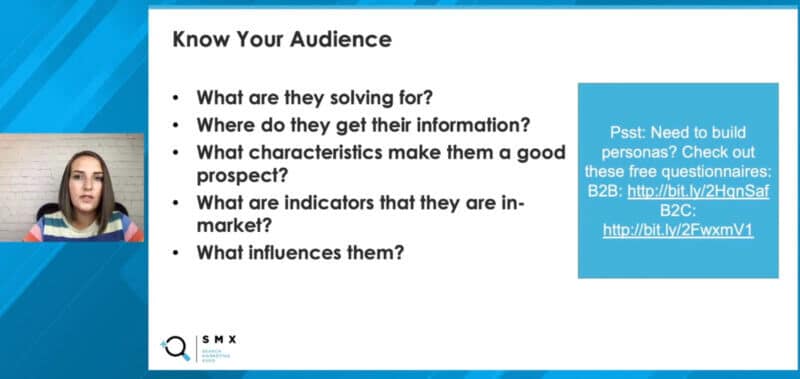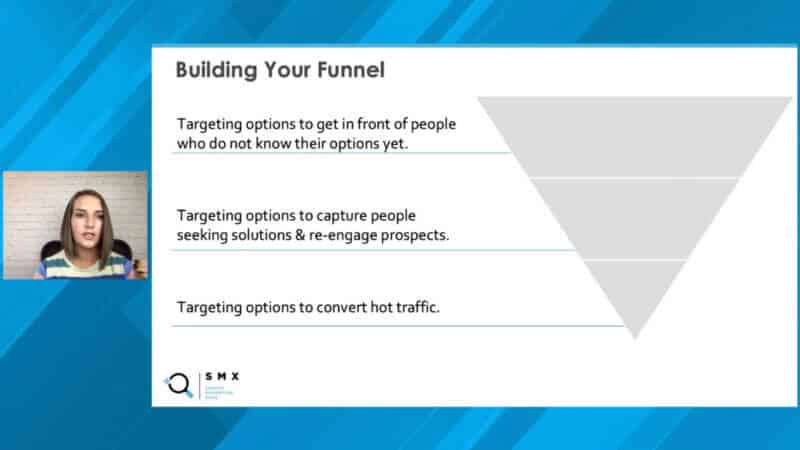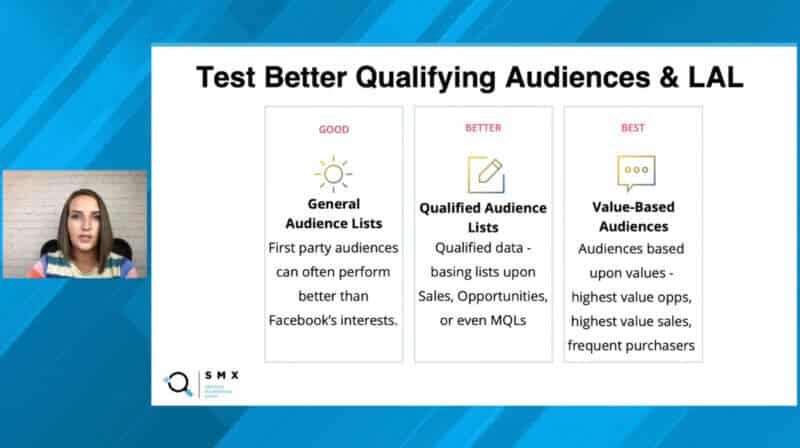In her hit session at today’s SMX Convert, Amy Bishop, Owner and Marketing Consultant and Cultivative, schooled us on multi-channel targeting tactics to turn prospects into paying customers. Her three-step strategy includes ways to better understand your audience, how to determine their varying paths to purchase, and tips to ensure that you’re targeting them at every stage along that path.
Knowing your target audience
Just like on the SEO side, it’s critical to have your personas handy for this exercise. If you don’t have a set group of personas, Bishop included a few questions to ask yourself about your potential target audience (plus some handy sheets for B2B and B2C):

She says the best way to dig into personas is to involve other client-facing teams, as well. This includes getting with customer support, sales, customer success, and more to answer these questions about your target audience.
- What is your target audience solving for?
- Where do they get their information?
- What characteristics make them a good prospect?
- What are indicators that they’re in-market?
- What influences them?
Along with asking these key questions, Bishop also recommends using the data you already have at your fingertips. “If you have a Facebook account, even if you’re not running ads, you have a wealth of information in Facebook audience insights,” she said. It’ll take some sorting through initially, but Bishop recommends identifying top purchaser demographics and zeroing in from there. After that, you can further segment by layering interests and other demographics and then identify specific interests to target. From there, you can monitor performance to flesh out and validate your personas.
Other sources of persona data that Bishop uses include the following:
- Google Ads audience insights,
- Google Analytics demographics insights, and
- Google Analytics conversion data.
Designing your campaigns to support the funnel
Catering to your prospects means supporting their journey toward that final conversion (whatever conversion is for your organization — it isn’t always a purchase!). “A common question that I get,” said Bishop “is which channels belong where [in the funnel]. I would really caution against this line of thinking because most channels have different ways that you can reach prospects. It doesn’t have to be ‘YouTube at the top, then display, and then search.’ You can make any channel work for you depending on who your prospects are and which channels they use and which targeting options are available across all channels.”
Instead, she recommends focusing on targeting options at each stage of the funnel:

In the first stage, work on targeting options that go for potential customers who don’t know all their options yet. After that, seek options that allow you to capture prospects seeking solutions and to re-engage those who have engaged in the past. Finally, at the bottom of the funnel, we want to target options to convert hot traffic to leads or sales.
Bishop maps this out in a spreadsheet asking these questions:
- What stage of the journey is the prospect in?
- What information do they need at that stage to feel comfortable moving to the next stage?
- What action or resource do we have available that is going to meet that information need that they have?
- How are we tracking it and creating an audience off of it?
In order to acquire this data to answer these questions, Bishop recommends looking into the data you DO have to complete this spreadsheet:
- First party data can tell you paths and interactions
- Client-facing resources can give you information on objections and questions
- Publicly available data can serve as market research
- Your market can give you info through customer surveys
Considerations for improving your campaign performance
If you’ve taken all the steps above and in Amy Bishop’s SMX Convert presentation and are still having some hiccups, here are some common mistakes she’s noticed in campaigns before.
Lack of data
“As marketers, we love to have control, so we end up making hyper-specific audience. But what happens is that we over-segment them and, even if [these small audiences have] brought conversions in the past, sometimes CPL and CPA can be pretty volatile,” said Bishop. With automation becoming more of a factor in PPC every day, platforms thrive on data. removing some of the segmentation (device, platform, etc.) can help create a larger audience. This can help give your bidding strategy a boost.
Not optimizing to a higher funnel conversion
“Even if you’re in the bottom of the funnel you can optimize to a higher in the funnel conversion,” she recommends. One of Bishop’s clients was struggling to get out of learning mode, so they tried optimizing to Add to Cart. They saw huge increases in ATC, a 91% increase in purchases, and a 155% increase in purchase value. These are all strategies worth testing for your campaigns if it makes sense.
Not testing better qualifying audiences and look-alikes
“Having any first-party data is good,” said Bishop. “That’ll only become more important as time goes on. Even better than that is putting some qualifications around it.” Analyze the behaviors of SQLs and work to find more of those by feeding those data values back into platforms.

The keys to improving your targeting are threefold, Bishop told us at SMX Convert. Really get to know your audience beyond surface persona data. Work to understand their path to purchase. And, finally, designs your campaigns around that path to purchase.
Want to see the whole session? Sign up to watch the entire SMX Convert learning journey on-demand.
The post Three PPC targeting tactics that power every stage of the funnel appeared first on Search Engine Land.
Source: IAB
